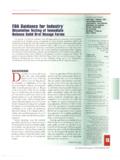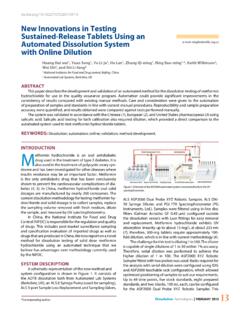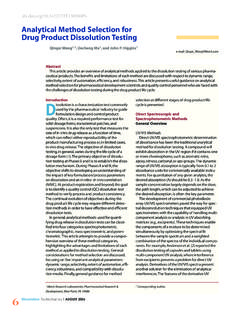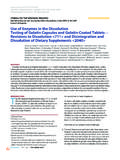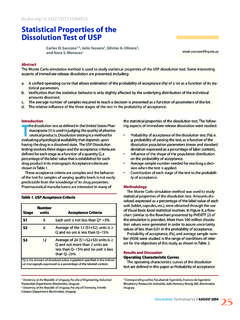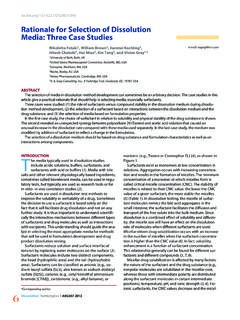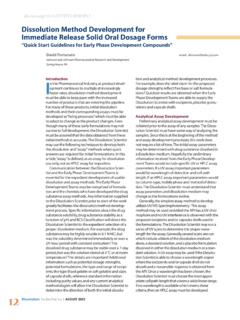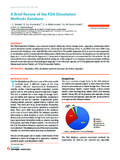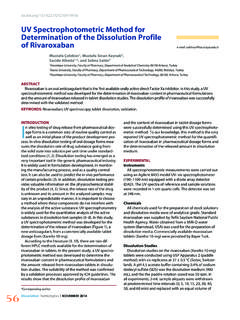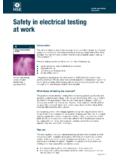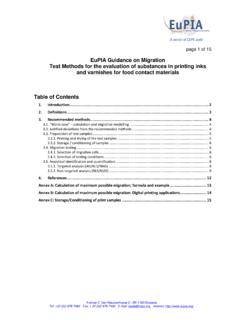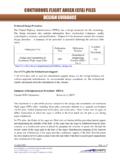Transcription of In Vitro Release Testing of Semi-Solid Dosage Forms
1 52 AUGUST 2017 BACKGROUNDI n Vitro Release Testing (IVRT) is used to monitor the Release and diffusion of drug products from semisolid Dosage Forms (1 11) and has long been considered a valuable tool in formulation development. IVRT has also been used to screen formulations to select promising candidates, (12 16) and, importantly, accepted for use to obtain a waiver of bioequivalence studies following postapproval changes to a product (17). A comprehensive review relating to the methodology, application, and equipment used in IVRT and published results using this technique is provided in this Vitro diffusion studies were used by Tehrani et al. (12) to investigate the influence of various additives on the Release of piroxicam from different topical vehicles, and they observed that the Release was considerably higher in formulations containing 2-propanol caused by decreasing the viscosity of the formulation which proved to be helpful in screening the formulations for relative availability of the drug.
2 The application of IVRT has many additional benefits such as its use in product development (18), identification of critical manufacturing variables, gauging in vivo performance, and product performance assessment including batch batch and lot lot uniformity (19). Its utility and value to assess the Release of active pharmaceutical ingredients (APIs) from semisolid Dosage Forms has been reported in numerous publications (20 32).A simple and reproducible method using vertical diffusion cell (VDC) systems and a synthetic membrane that could be readily adopted for the quality control of semisolid products was first developed and demonstrated by Shah et al. in 1989 (22). An IVRT method for assessing the Release of diclofenac dimethylamine from topical gels was developed by Goebel et al. (33). A significant difference was observed between the fluxes of the tested products.
3 These differences in the performance of topical products were thought to be due to the influence of excipients and vehicle components and, thus, highlight the influence of excipients. The in Vitro Release rates of acyclovir from generic creams approved in South African and Indian markets were evaluated and compared with the innovator products available in the respective markets using VDCs in order to determine the sameness of those approved generic products based on the in Vitro data (15). The in Vitro Release comparisons were based on the recommendations described in the United States Food and Drug Administration (FDA) Draft Guidance for acyclovir ointment (34) and the SUPAC-SS Guidance for nonsterile semisolid Dosage Forms (17). Plots of the Release rates (slopes) of the cumulative amounts of acyclovir released versus the square root of time for the various generic formulations compared with the reference product were found to be within the limits of to with a 90% confidence interval.
4 These experiments indicate that the generic acyclovir cream formulations exhibited Release rates that were comparable to the innovator product and could be considered pharmaceutically equivalent. Whereas dissolution Testing is considered as an important test to determine the Release of non-solution products which are administered via an extravascular route (generally orally) and intended for the systemic circulation, drug Release from products which are topically applied to the skin is considered equally important. Topical dermatological products, usually semisolids such as creams, ointments, emulsions, foams, gels, and lotions, amongst others, are generally intended for local action on or in the skin where the drug is not destined for the systemic circulation (35). In certain instances where a transdermal Dosage form is specifically intended for local action only, IVRT should be readily applicable whereas in Vitro Testing of transdermal Dosage Forms intended for systemic absorption, in Vitro penetration tests (IVPT) using various types of skin samples as the membranes may be the preferred approach.
5 However, there can be semisolids with systemic action, and there are transdermal delivery systems with local action approved by the FDA for the United States market. Topical products intended for the systemic circulation require penetration beyond the stratum corneum and In Vitro Release Testing of Semi-Solid Dosage Forms Isadore Kanfer1,2,*, Seeprarani Rath3, Potiwa Purazi3, Nyengeterai Amanda Mudyahoto31 Faculty of Pharmacy, Division of Pharmaceutics, Rhodes University, Grahamstown, 6140, South Africa2 Leslie Dan Faculty of Pharmacy, University of Toronto, Toronto, ON, M4V 3B9, Canada3 Biopharmaceutics Research Institute, Rhodes University, Grahamstown, 6140, South : author53 AUGUST 2017epidermis layers of the skin, whereas topical products used dermatologically for local action are not intended to be absorbed, and, hence, Release only from such Dosage Forms as the major pre-requisite.
6 When two products with the same or similar composition ( , contain the same components [Q1], and the same amounts of the same components [Q2]), potential differences between the test and reference product may be due to the issues of structural dissimilarity (Q3) relating to the arrangement of matter and state of molecular aggregation. Differences between such products can often be identified using IVRT since the in Vitro drug Release is generally a property of the drug formulation (9). Given its acceptance as a useful tool to assess product sameness (17), IVRT is the first step towards the goal of Quality by Design which emphasizes the development of meaningful drug product specifications based on clinical performance (19). However, semisolid Dosage Forms are generally complex multiphase formulations where factors such as the size of the dispersed particles, interfacial tension between phases, and the rheology of the formulation, amongst others, determine the physical properties of the system (18).
7 Although several attempts to validate IVRT methods have previously been published (36 47), none have described appropriate validation procedures relating to control the essential validation components such as VDC dimensions, system temperature, volume of receptor fluid, stirring speed, membrane compatibility, and other associated physical and operational variables to ensure reproducible and reliable results. Unlike oral drug products, there has been an absence of regulatory guidelines regarding appropriate validation procedures for the IVRT of locally acting topical products, although recently, a new FDA guideline on acyclovir cream using IVRT (48) provides some information relating to IVRT validation. Various reports have shown that alterations in IVRT method parameters can influence the results and clearly indicate that it is essential to assess the influence of each IVRT method parameter on the resulting data (49, 50).
8 Although in Vitro studies have not generally found acceptance by most regulatory agencies to establish bioequivalence, draft guidances on the antiviral drug product acyclovir ointment and cream have been published by the FDA (34, 48). These guidances recommend the use of in Vitro methodology and additional associated Testing to determine the bioequivalence of acyclovir topical ointments and creams (34, 48).EQUIPMENT AND METHODOLOGY IVRT has been established as a compendial method by the USP, and the compendial apparatuses and procedures for these tests are described in the USP General Chapter <1724> (51).USP Apparatus 4: Flow-Through Cell ApparatusIn the flow-through method, the test sample is in a small volume cell through which media is pumped at a constant temperature. Upon leaving the cell, the eluate is filtered and can then be analyzed directly or collected in fractions to calculate the percent drug Release (52).
9 Several other automated and flow-through methods have also been used (30, 31, 53 56). An "insertion cell used in conjunction with a compendial flow-through cell (USP) has been described by Chatteraj and Kanfer (31) where the Release of acyclovir from semisolid Dosage Forms was monitored. The results were found to compare favorably with previous acyclovir Release data using different diffusion cells and indicated that their insertion cell offered distinct advantages compared to VDCs in that it is easier to use and readily adaptable for use with the compendial flow-through apparatus. A further advantage of this insertion cell is that, unlike other VDCs where air bubbles at the membrane/liquid interface often occur, such problems are avoided (31).Diffusion CellsDiffusion cells can be classified as horizontal, vertical, or flow-through based on their physical design.
10 These cells can also be used along with numerous modifications to the basic design. The VDC, recommended by the USP, is one of the more widely accepted apparatuses for in Vitro Figure 1. Vertical Diffusion Cellaa<1724> Semisolid Drug Products Performance Tests. In The UnitedStates Pharmacopoeia and National Formulary USP 39 NF 34; 2016;38; pp 1869-81 (57).54 AUGUST 2017diffusion studies (19) and by far the most commonly used in Vitro model for the study of drug Release from topical Dosage Forms (57). An example of a typical VDC is shown in Figure VDC assembly consists of two chambers: a donor chamber and a receptor chamber. Each chamber is separated by a membrane. A layer of the semisolid product under evaluation is placed in the donor chamber on top of the membrane in contact with the receptor medium in the receptor chamber.
